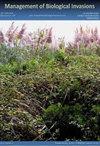评估一种生长不确定的侵入性脊椎动物捕食者的最大个体的致死毒物剂量
IF 1.2
4区 环境科学与生态学
Q3 BIODIVERSITY CONSERVATION
引用次数: 7
摘要
棕色树蛇(Boiga irregularis)被意外引入关岛,造成了严重的生态和经济破坏。对乙酰氨基酚是一种有效的、低风险的口服毒饵剂,已开发出一种用于景观规模毒饵投放的自动空中投放系统(ADS)。在之前的试验中,将固定剂量80毫克的对乙酰氨基酚片剂插入死的新生小鼠(DNM)中,对所有褐树蛇都是致命的;然而,这些试验没有包括非常大的个体,这是很难获得测试。因为大多数爬行动物在一生中都在继续生长,所以有一小部分的体型会比平均体型大得多。在这里,我们测试了80毫克对乙酰氨基酚DNM诱饵对异常大的棕色树蛇的有效性。我们的研究结果证实,对关岛绝大多数蛇来说,80毫克的剂量是致命的,但在体重达到200克左右时,效果就会开始下降。我们还测试了另一种老鼠诱饵配置,其中含有160毫克对乙酰氨基酚,可以加入到ADS中,以改善对异常大蛇的控制。160毫克的剂量预计对几乎所有雌蛇都有效;雄性的体型要大得多,对于体型特别大的个体,就需要额外的方法。我们描述了褐树蛇对扑热息痛片的完整剂量-反应曲线,并估计ld90为299 mg/kg, ld99为578 mg/kg。据我们所知,这是首次发表的具有不确定生长的侵袭性脊椎动物的剂量-反应曲线。本文章由计算机程序翻译,如有差异,请以英文原文为准。
Evaluating lethal toxicant doses for the largest individuals of an invasive vertebrate predator with indeterminate growth
The brown treesnake ( Boiga irregularis ) was accidentally introduced to Guam and caused severe ecological and economic damages. Acetaminophen is an effective, low-risk oral toxicant for invasive brown treesnakes, and an automated aerial delivery system (ADS) has been developed for landscape-scale toxic bait distribution. A fixed dose of 80 mg of acetaminophen within a tablet inserted into a dead neonatal mouse (DNM) was lethal for all brown treesnakes in previous trials; however, these trials did not include very large individuals which are difficult to acquire for testing. Because most reptiles continue to grow throughout their lifespan, a small number reach much greater than average body sizes. Here, we tested effectiveness of 80 mg acetaminophen DNM baits for unusually large brown treesnakes as they became available. Our results confirmed that an 80 mg dose is lethal for the vast majority of snakes on Guam, but efficacy starts to diminish around 200 g of body mass. We also tested an alternative mouse bait configuration with 160 mg of acetaminophen that could be incorporated into the ADS to improve control of unusually large snakes. The 160 mg dose is expected to be effective for nearly all female snakes; males grow much larger and additional methods will be needed for extraordinarily large individuals. We describe a full dose-response curve for brown treesnakes to acetaminophen tablets and estimate the LD 90 at 299 mg/kg and the LD 99 at 578 mg/kg. To our knowledge, this is the first published dose-response curve for an invasive vertebrate with indeterminate growth.
求助全文
通过发布文献求助,成功后即可免费获取论文全文。
去求助
来源期刊

Management of Biological Invasions
Agricultural and Biological Sciences-Ecology, Evolution, Behavior and Systematics
CiteScore
3.40
自引率
6.70%
发文量
21
审稿时长
16 weeks
期刊介绍:
Management of Biological Invasions, established in 2010 by Dr. Elias Dana, is an open access, peer-reviewed international journal focusing on applied research in biological invasions in aquatic and terrestrial ecosystems from around the world. This journal is devoted to bridging the gap between scientific research and the use of science in decision-making, regulation and management in the area of invasive species introduction and biodiversity conservation.
Managing biological invasions is a crisis science, with Management of Biological Invasions aiming to provide insights to the issues, to document new forms of detection, measurements and analysis, and to document tangible solutions to this problem.
In addition to original research on applied issues, Management of Biological Invasions publishes technical reports on new management technologies of invasive species and also the proceedings of relevant international meetings. As a platform to encourage informed discussion on matters of national and international importance, we publish viewpoint papers that highlight emerging issues, showcase initiatives, and present opinions of leading researchers.
 求助内容:
求助内容: 应助结果提醒方式:
应助结果提醒方式:


